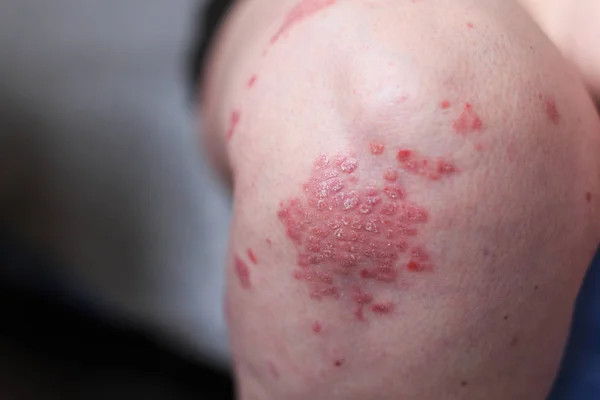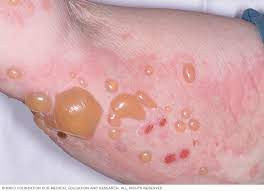Definisi
Lupus Eritematosus Sistemik atau sering dikenal dengan penyakit lupus adalah penyakit autoimun kronis yang dapat berdampak ke banyak organ dalam tubuh. Pada dasarnya, sistem imunitas tubuh atau sistem kekebalan tubuh pada pasien lupus akan menganggap organ dalam tubuh sebagai benda asing sehingga akan dihancurkan oleh sistem kekebalan tubuh sendiri, sehingga menyebabkan peradangan dan pembengkakan pada berbagai organ dalam tubuh.
Kejadian lupus paling sering terjadi pada wanita usia muda, walaupun tidak menutup kemungkinan siapa saja dapat terkena penyakit ini.
Karena lupus dapat menyerang berbagai organ dalam tubuh, maka lupus dapat muncul dengan berbagai gejala, antara lain:
- Kulit: Terjadi masalah pada kulit seperti ruam merah pada pipi dan hidung
- Darah: Penurunan drastis pada sel darah merah dan sel darah putih
- Sendi: Radang sendi sangat umum terjadi pada pasien lupus. Nyeri dan kekakuan sendi juga sering terjadi
- Ginjal: gangguan ginjal pada penderita lupus sering terjadi dan dapat mengancam jiwa
- Otak: Untungnya, keterlibatan otak dalam penyakit lupus cukup jarang. Namun, bila otak terlibat maka konsekuensinya dapat terjadi penurunan kesadaran, kejang, dan strok
- Jantung dan paru: Keterlibatan jantung dan paru paling banyak yaitu perikarditis, disebabkan karena peradangan pada perikardium atau selaput yang melapisi jantung sehingga dapat menyebabkan sesak napas, irama jantung yang tidak teratur, dan penumpukan cairan di sekitar paru dan jantung
Baca selengkapnya mengenai perikarditis, di sini: Perikarditis - Definisi, Penyebab, Gejala dan Pengobatannya
Penyebab
Secara umum, penyebab lupus masih belum diketahui secara pasti hingga saat ini. Peneliti masih mencari penyebab pasti yang memengaruhi sistem kekebalan tubuh yang menganggap sel tubuh diri sendiri sebagai benda asing. Namun, terdapat beberapa faktor yang dicurigai menjadi penyebab lupus, antara lain:
Perubahan Hormon
Berdasarkan riset, penderita lupus lebih banyak berjenis kelamin wanita. Hal ini dicurigai akibat perubahan hormon seperti estrogen. Lupus sering terjadi pada wanita usia 15-44 tahun ketika perubahan hormon masih terjadi.
Faktor Lingkungan
Berbagai faktor yang terjadi di lingkungan dapat menyebabkan seseorang terkena lupus. Faktor lingkungan tersebut contohnya jumlah paparan sinar matahari yang didapat, penggunaan obat-obatan tertentu, paparan debu silika pada industri tertentu, paparan virus tertentu seperti virus Epstein-Barr, stres fisik ataupun psikis, serta riwayat merokok dapat berkontribusi sebagai penyebab dari lupus.
Faktor Genetik
Bila terdapat riwayat lupus pada keluarga Anda, maka risiko anda terkena lupus pun akan meningkat.
Faktor Risiko
Faktor risiko dari lupus antara lain adalah:
- Jenis kelamin wanita
- Usia 15-44 tahun
- Ras tertentu, lupus lebih sering terjadi pada etnis afro-amerika, hispanik, dan orang dengan keturunan asia-amerika
- Riwayat pengobatan tertentu
- Merokok
- Bekerja di industri dengan paparan zat kimia yang tinggi
Gejala
Gejala dari lupus dapat bervariasi akibat penyakit ini yang menyerang berbagai organ dan sistem dalam tubuh. Gejala yang dialami setiap orang juga dapat berbeda tergantung dengan derajat keparahan lupusnya. Maka dari itu, gejala dan pengobatan lupus harus dilakukan secara intens dan berkelanjutan pada tiap pasien. Gejala lupus berupa:
- Nyeri sendi
- Nyeri otot
- Ruam merah pada wajah dan kulit
- Demam
- Sensitif terhadap paparan cahaya
- Rambut rontok
- Mulut kering
- Mata kering
- Kelelahan
- Nyeri dada
- Nyeri perut
- Sesak napas
- Kelenjar yang bengkak
- Nyeri kepala
- Kebingungan
- Depresi
- Kejang
- Penggumpalan darah
- Anemia
Seperti yang sudah dikatakan tadi, setiap orang dapat terkena lupus namun kejadiannya lebih tinggi dan sering terjadi pada wanita. Pada wanita, terdapat gejala lupus yang sangat khas yakni butterfly rash atau ruam berbentuk kupu-kupu yang berwarna merah dan berlokasi di pipi dan batang hidung.
Biasanya ruam ini akan lebih terlihat ketika wajah terkena paparan sinar matahari berkepanjangan dan terkadang juga disertai rasa gatal. Ruam juga dapat muncul di bagian kulit lain.
Baca Juga: Lupus Eritematosus Kulit - Definisi, Penyebab, Gejala dan Pengobatannya
Diagnosis
Bila Anda dicurigai terkena lupus, maka dokter perlu melakukan serangkaian pemeriksaan untuk menentukan diagnosis dan derajat keparahan dari penyakit sehingga bisa diberikan pengobatan dan tata laksana yang sesuai. Dokter akan melakukan anamnesis atau pemeriksaan fisik, pemeriksaan fisik, dan pemeriksaan penunjang.
Wawancara Medis
Wawancara medis merupakan sesi tanya jawab antar dokter dan pasien diperlukan sebagai langkah awal dalam menggali faktor risiko. Dokter akan menanyakan:
- Keluhan utama pasien
- Keluhan penyerta
- Sejak kapan keluhan tersebut muncul
- Riwayat pengobatan tertentu
- Riwayat penyakit terdahulu
- Riwayat penyakit keluarga
Pemeriksaan Fisik
Selanjutnya, dokter akan melakukan pemeriksaan fisik. Pemeriksaan fisik dimulai dengan melakukan pemeriksaan tanda vital pasien seperti tekanan darah, suhu tubuh, laju napas, dan nadi. Kemudian dokter akan memeriksa tubuh pasien dari ujung kepala hingga ujung kaki untuk mencari gejala klinis seperti:
- Gangguan kesadaran
- Kerontokan rambut
- Ruam pada kulit
- Nyeri sendi
- Mulut atau mata kering
- Kelenjar yang bengkak
Pemeriksaan Penunjang
Kemudian, yang tak kalah penting dokter akan melakukan pemeriksaan penunjang.
Pemeriksaan Laboratorium
- Darah lengkap: untuk mencari kadar sel darah merah, penanda radang dalam darah, laju endap darah
- Urin lengkap: untuk melihat apakah ada kandungan protein, darah dan nanah untuk melihat apakah ada keterlibatan ginjal dalam kondisi pasien
- Kimia darah: untuk melihat fungsi hati dan fungsi ginjal
Pemeriksaan Khusus
Selanjutnya, dokter juga dapat melakukan pemeriksaan autoantibodi bila memungkinkan untuk melihat kadar antibodi spesifik terhadap lupus, yakni:
- Antibodi Antinuklear (ANA)
- Antibodi anti-double stranded DNA (anti-dsDNA)
Seluruh pemeriksaan akan direkomendasikan oleh dokter, jadi pastikan konsultasi terlebih dahulu sebelum melakukan pemeriksaan penunjang.
Tata Laksana
Dokter akan memberikan pengobatan terhadap pasien lupus bergantung dengan gejala yang dialami, keparahan gejala, usia, keadaan anda secara umum, dan riwayat penyakit anda. Lupus merupakan kondisi penyakit kronis dan membutuhkan perawatan untuk mengontrol gejala seumur hidup sehingga kontrol rutin ke dokter sangat diperlukan untuk memperbaiki kualitas hidup.
Berikut beberapa tata laksana yang dapat diberikan terhadap pasien lupus:
- Pemberian obat anti-radang untuk menghentikan proses peradangan yang terjadi secara terus menerus
- Pemberian obat imunosupresan untuk menekan agar sistem kekebalan tubuh tidak menyerang sel tubuh sendiri
- Pemberian obat anti-malaria terbukti membantu meredakan gejala dan membantu mencegah kekambuhan
- Agen biologis untuk mengurangi jumlah protein yang dapat memicu lupus
- Perubahan gaya hidup seperti mengontrol stres, makan makanan tinggi nutrisi, perbanyak buah dan sayur, tidur yang cukup, mengurangi paparan sinar matahari dan zat kimia, serta rutin berolahraga.
Komplikasi
Komplikasi dari lupus yang sering terjadi, antara lain:
- Gangguan ginjal: Komplikasi yang umum terjadi dan menjadi penyebab utama kematian pada penderita lupus
- Gangguan pada otak dan sistem saraf pusat: Bila lupus melibatkan organ otak dan sistem saraf pusat, maka pasien dapat merasa pusing, bingung, dan memiliki penurunan kesadaran
- Darah dan pembuluh darah: Keterlibatan darah dan pembuluh darah dapat menyebabkan radang pada pembuluh darah dan gangguan pada proses pembekuan darah
- Paru-paru: lupus dapat menyebabkan radang pada selaput di sekitar paru sehingga menyebabkan nyeri saat bernapas
- Jantung: Peradangan pada jantung dan peningkatan risiko terjadinya serangan jantung meningkat pada pasien lupus
- Infeksi: Orang dengan lupus secara umum lebih mudah untuk terkena infeksi apapun karena sistem kekebalan tubuhnya yang lebih lemah dibanding orang lain
- Kanker: Peningkatan risiko terkena kanker
- Kematian jaringan tulang: Hal ini terjadi ketika aliran darah ke tulang menurun
- Komplikasi kehamilan: Pada wanita hamil penderita lupus, peningkatan terjadinya komplikasi pada kehamilan meningkat seperti risiko keguguran, pre-eklampsia, dan kelahiran prematur
Jika Anda ingin mengetahui lebih lanjut mengenai preeklamsia, Anda dapat membacanya di sini: Preeklamsia - Definisi, Penyebab, Gejala dan Pengobatannya
Pencegahan
Tidak ada cara khusus untuk mencegah lupus karena penyebabnya yang masih belum diketahui secara pasti. Namun bila Anda memiliki faktor risiko lupus, Anda dapat melakukan pola hidup sehat, seperti:
- Makan makanan bergizi seimbang
- Menghindari makanan ultra proses yang tinggi pengawet
- Melakukan aktivitas fisik yang sesuai dengan olahraga minimal 150 menit per minggu
- Mengendalikan stres dengan baik
- Menghindari paparan sinar matahari secara berlebih
- Menghindari paparan zat kimia baik dari rokok ataupun tempat kerja
Kapan Harus ke Dokter?
Segeralah ke dokter bila Anda mengalami gejala di atas dan memiliki faktor risiko terhadap lupus. Anda dapat mengunjungi dokter umum atau dokter spesialis penyakit dalam terlebih dahulu, bila ada kecurigaan ke arah lupus maka dokter umum akan merujuk anda ke dokter spesialis penyakit dalam konsultan rheumatologi.
Mau tahu informasi seputar penyakit lainnya? Cek di sini, ya!
- dr. Monica Salim
Centers for Diseases and Prevention (CDC) - Systemic Lupus Erythematosus. (2022). Retrieved 8 December 2022, from https://www.cdc.gov/lupus/facts/detailed.html
Cleveland Clinic - Lupus (Systemic Lupus Erythematosus) (2021). Retrieved 8 December 2022, from https://my.clevelandclinic.org/health/diseases/4875-lupus
Mayo Clinic - Lupus (2022). Retrieved 8 December 2022, from https://www.mayoclinic.org/diseases-conditions/lupus/symptoms-causes/syc-20365789
Medscape - Systemic Lupus Erythematosus (2022). Retrieved 8 December 2022, from https://emedicine.medscape.com/article/332244-overview
Medline Plus - Systemic lupus erythematosus (2021). Retrieved 8 December 2022, from https://medlineplus.gov/ency/article/000435.htm











